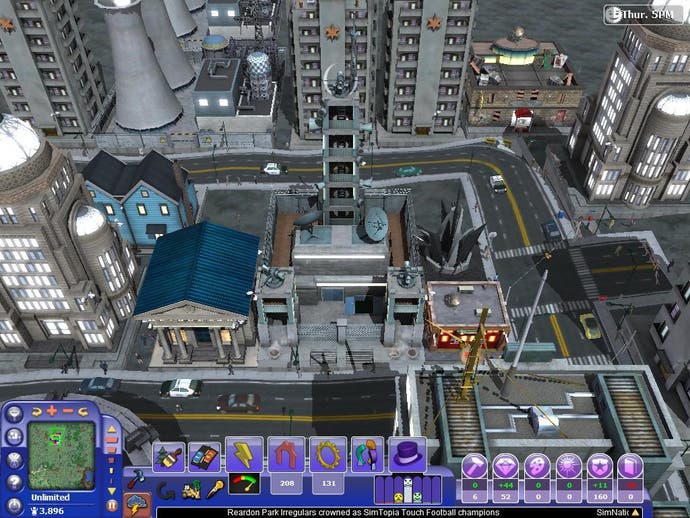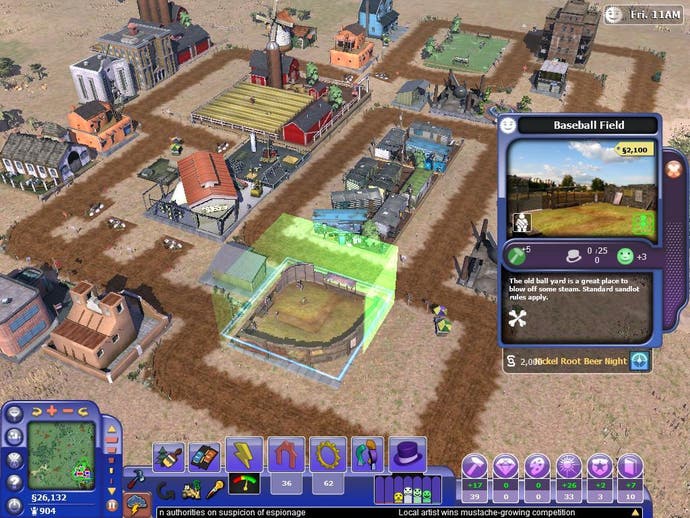SimCity Societies
Constructive criticism
Back at the dawn of this bold new millennium, EA and Maxis had the idea of creating a game that would sit neatly in between their two globe-conquering franchises - the detail-obsessed SimCity and the close-up antics of The Sims. Simsville was to be the name, but the project was canned in 2001 when it became clear that more straight Sims spin-offs were what the public craved most. Six years later, and Simsville is back - at least in spirit.
Like its abandoned predecessor SimCity Societies zooms up from The Sims and down from SimCity, in the hope of finding some nook or cranny of gameplay left untapped by those twin leviathans of PC gaming. In doing so, it has raised the ire of fans, who have screamed bloody murder at the notion of a SimCity game without zoning and micromanagement, but most of all at the sheer horror of a SimCity game produced by someone other than Maxis. Caesar IV developer Tilted Mill has been called to bat this time out and while the kneejerk fears of the hardcore SimCity crowd haven't been particularly constructive, they've turned out to be fairly accurate. Societies is a muddle of ideas, tied to a rather lumpy city building engine.
There's not much point comparing it directly to SimCity games of the past, since it's almost completely different in style and tone. SimCity 4 may have grown terrifying and bloated for the average player, but Societies simplifies things to an often depressing degree. Rather than designating zones for industrial, commercial and residential use, you now place individual buildings. This is the biggest change, and it fundamentally alters what SimCity is about. In place of the pragmatic red, yellow and blue zones of old, we now have six ephemeral "social energies" - productivity, prosperity, authority, creativity, spirituality and knowledge. Every building either produces, or consumes, one or more of these energies. So, for instance, a museum for children creates knowledge but consumes creativity.

"Wait a minute", I hear you cry, "Surely a kids museum would foster creativity?"
And you'd be right. In the real world. But this is Sim World and the energies often manifest in less than logical ways. Blue collar workplaces like a textile factory should, you'd think, add productivity to a city yet instead they use it up. It's not always clear what the criteria is for consumption over production, so the whole concept of "social energies" ends up rather vague and woolly. Not that this matters, since the game includes a rather clunky workaround in the form of decorations. These are items that serve no practical purpose, yet boost your city's supply of the various energy types. In other words, should you not have enough spirituality for your monastery to "work" (again, how does that make sense?) you can simply build a prayer bell and the problem is conveniently resolved. Quite why a bell provides more spirituality than a bloody monastery is just one mystery the tutorial fails to explain.
And it's here that the first of several flaws in the core game design become apparent. The tutorial handily tells you that your power stations don't need to touch or connect to the buildings they supply. It's true. You can plonk a nuclear plant on the other side of the map, and the electricity magically flows to your buildings regardless. The tutorial also encourages you to think of the "social energies" in the same way as electricity - a resource that every building requires to operate. Can you see where this is leading? That's right. You can boost your supply of any energy simply by scrolling to a distant corner and slapping a bunch of decorations down. Build five public murals in the middle of nowhere, miles from your city, and you can get 40 creativity points despite the fact that none of your citizens can actually see them.

That's not the only quirk. The relationship between population and accommodation is unclear as well. I had a city with almost 3,000 inhabitants despite only having built accommodation for a few hundred. And yet apparently none were homeless. Weird. The same is true of jobs. Each workplace you build only offers a handful of jobs, yet the population seems to grow in leaps regardless of career opportunities. Regardless of anything, in fact, since you'd have to deliberately make your city deeply unpleasant in order to even slow the tide of new citizens. Desperate Sims can go "rogue" and start causing trouble, but you literally have to make your city a living hell before that becomes a real problem.
Yet the game does a fairly good job of giving the illusion of depth. There are statistics galore, and loads of little numbers attached to almost every icon. For the casual gamer, who the game seems to be aimed at, it all looks very impressive. And there are balances to be struck - even if it is just between work and fun, with Venues supplying the latter and occasionally offering temporary status boosts like nickel beer night at the ball park, or a glitzy movie premiere. You can opt to build a city dominated by one type of energy, in which case the environment evolves to suit the mood - from dystopian nightmare for Authoritarian cityscapes to pastoral tranquillity for those governed by Spirituality - but, beyond seeing what each of the 500 available building types look like, there's not much incentive to keep plugging away to unlock them all. Thanks to the disconnect between what you do and how the city develops, there's no real sense that you're building something tangible. Sandbox games like this inevitably hit a plateau at some point, where the desire to tinker must become a need to keep playing if interest is to be maintained, and Societies hits that plateau much sooner than its rivals. This is even despite the presence of a freeplay mode, available from the start, which removes all restraints from the buildings you can purchase and place.

There's definitely mileage in a city building game that acknowledges the fact that people live there, not just statistics, but City Life already did the "social energy" concept in a more interesting way by actually focussing on friction between social groups. In Societies, even though you can click on each inhabitant to see how they feel, the energies are all attached to the buildings, not the people. They may turn into hippies, or cops, or even clowns should they spend the right time in the right place, but there's a creeping sense that your choices are affecting the visuals a lot more than the gameplay.
Things aren't helped by the rather crude build interface, which bizarrely allows you to rotate items and buildings at 45 degree angles, even though you can only build roads in straight lines. Yep, that's right - we're back to the old right angled corners, with a jittery road placement tool that would have felt clumsy ten years ago. Unless you're painstakingly patient cities end up following make-do layouts, their jagged highways populated by a jarring mixture of building styles and types dictated by the nebulous "social energy" concept rather than anything that looks or feels like genuine city planning.
Those Maxis-faithful naysayers who crowed that Tilted Mill would sully their beloved series have sadly been proven right as the game suffers from many of the same complaints levelled at the studio's previous game, Caesar IV. But let me make my final point quite clear - Societies doesn't stumble just because "it isn't SimCity". Fresh takes on old concepts should always be welcome. It stumbles because it's a generally unsatisfying patchwork of a game, dragged down by inconsistent gameplay, outdated design and weirdly implemented ideas.








